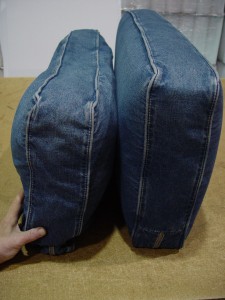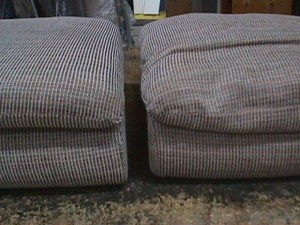Identify The Warning Signs of a Declining Seat or Sofa Cushion Before It’s Too Late!
When you’re watching the clock crawl backwards at work, with your back and neck aching from your poorly-designed desk, while ringing phones and non-stop messages fry your nerves, where’s the one place you’d rather be?
Besides “a private beach,” or “anywhere else,” the answer for many people is in their favorite couch or chair at home, unwinding in comfort with family, friends, or just relaxing with a bowl of popcorn and a movie. And while what we do to decompress matters, what ultimately makes the experience so enjoyable is the comfort the seat provides. Sitting on a cold, hard floor to watch the big game sounds like punishment, but if you’ve got a plush, supportive couch to sink into, watching your alma mater pound their rivals into powder is all you’ll think about for weeks!
Superb seat comfort is key to having that oasis amid the grind of everyday life, and it depends solely on the condition and quality of the foam used in your cushions.
The first thing to understand about keeping foam seat cushions in great shape is why they wear out to begin with. Open-cell comfort foam is made of a web of tiny, spindly struts, the structural remains of millions of burst foam bubbles. After thousands of hours spent supporting the weight of seated individuals, and the flex and pressure of the ins-and-outs of seating, foam struts break down, lose the ability to bear weight, and are unable to return to their original dimensions.
Fortunately, by following the handful of tips in this article, you can keep on top of the condition of your upholstery and make sure you nip aging cushions in the bud, before the comfiest seat in the house loses its title.
The Visual Check
When seat and couch cushions are brand-new, their foam inserts are cut slightly larger than the fabric covers they will be housed in. Because foam is so compressible, inserts are squeezed into covers, giving you that ultra-stuffed appearance seen on many types of upholstered furniture. At the very least, new inserts give their cushions clean, sharp lines and smooth edges.
But as a cushion breaks down, it will literally shrink in size, as it loses the ability to return to its original dimensions. And as it loses size, it will no longer fill the cover as fully as it once did. If you notice a sagging cover when a cushion isn’t being sat on, or a cover that’s wrinkled or “scrunched” at the corners, your foam is losing the resilience that kept it pressed against its cover, and provided you with comfort and support. A perpetually sagging, loose, or wrinkled cushion cover is a major sign you will soon need to replace your foam cushion.
The Comparison
While the visual cover-check works well on seats that were originally fluffy and over-stuffed, lower profile seating may not provide such a drastic visual indicator as an insert ages. But for loveseats and full-size couches, having the ability to compare your favorite seating spot’s cushion to the other sofa cushions may enlighten you to the fact that your foam’s resilience is nearing the point of no return.
While you could place them side-by-side, inspect them with a magnifying glass, or get out a scale and try to measure compression, the easiest way to perform a comparison test is to shuffle your most-frequently sat-in cushion with the least sat-in cushion. Sit in one for a minute or two, wiggle around a bit, and get a feel for its support. Then, get up, and replace it with a cushion from the far end of the couch. If it feels springier, fuller, and stronger, the previous cushion is wearing out. You could always buy a little time and re-organize cushions so the worn one goes in the least-used spot on the couch, but that’s only delaying the inevitable.
It’s important to note that when trying this test, you place the comparison cushions in the same spot on the couch as the one you suspect of wearing out, as opposed to sitting at an end, then moving to the middle for example. The frame and build of a sofa or seat affects how you sit and are supported, so your body sits differently in an end seat than it does in a middle seat, and so on. Of course, this test is anything but scientific, but attempting to make things as close to apples-to-apples as possible can only help you notice differences.
The Reality Check
When you’re sitting in that favorite spot, do you find yourself constantly fidgeting and adjusting yourself? Sometimes, especially while distracted by TV, computers, or reading, we can overlook our body trying to get comfortable or relieve built-up pressure from an under-supportive cushion. If you consciously keep track of how often you have to “reset” and look for a new position or posture, you may realize you’re constantly trying to get comfortable, and that’s a big problem.
While it’s the most difficult way to assess a comfort seat cushion, being able to remove yourself from the situation, figuratively speaking, and objectively analyze the feel of your cushion, will give you a definitive answer as to whether or not you should be looking for replacement foam. It takes a degree of self-awareness to notice whether or not you’re actually a little uncomfortable though – much different than noticing you bottom out to the springs – expressly what makes the reality check comparatively difficult. But if you can take a step back and remember how plush, comfy, and relaxing your seat first was, and can tell it’s no longer in such a condition, you’ll have the definitive answer as to whether you need to start considering cushion replacement!
Tags: Comfort Foam, Couch Cushion, Cushion Replacement, Foam Replacement, Open-Cell Foam




What, exactly, does the term ‘loss of resiliency’ mean in a furniture contract. I liked your article. My cushions are not any longer comfortable for sitting and I shift constantly. They are disfigured and sagging, too. Is this the type of ‘loss of resiliency’ that will be covered my extended warranty?
Loss of resiliency means cushions don’t return back to their original height. It also means that the cushions are softer than they originally were do to wear and tear.
Great article, Can I ask it this loss of resiliency anything to do with cushions that don’t return back to their original shape. The cushions on my less than year old sofa do not lie back flat anymore and curl up like toast corners? I think it is a sign cheap foam has been used although the shop / manufacturer say it is personal preference and the foam is up to spec. Thanks for an informative article.
Usually a low quality foam is used from the factory. You can price out and order custom cut cushions through our website.
All three cushions on our sofa have gone flat. What information on size shape etcetera do you need to make us from fillers?
Please see our custom seats and cushions page for more information. When you click on the shape that matches your cushion, additional measuring instructions are given (PDF of How To Guide). If you have a shape that is not shown, contact us for more details.
My week old sofa is nor bouncing back. Supplier not helpful.
Please advise.
You can price out and custom order cushion foamcushion foamcushion foam on our website. Or you may contact us directly for assistance.
I want to replace the cushions in my husbands recliner. He is a big and tall man which makes the cushions not outlast the recliner. He is 6’ tall and weighs 290. What foam will do the job? Thanks you so much.
Foam medium foam, we would suggest our HD36-HQ foam. For firm foam, we would suggest our Lux-HQ foam.
I just bought a naples sectional by broyhill havent even sat on it yet i noticed some of the back pillows at the top are really filled out wheres the other side they are not..I wonder if its because when i got it delivered they had to different plastics so tight around the sofa it caused those problem area also from them grabbing the top pillows tgat are attached to get it in the door not sure what to do as i just got it and havent sat on it yet..
Please Contact Usfor further information regarding your inquiry.